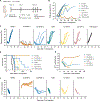Preclinical studies show that Co-STARs combine the advantages of chimeric antigen and T cell receptors for the treatment of tumors with low antigen densities
- PMID: 38985855
- PMCID: PMC12226805
- DOI: 10.1126/scitranslmed.adg7123
Preclinical studies show that Co-STARs combine the advantages of chimeric antigen and T cell receptors for the treatment of tumors with low antigen densities
Abstract
Two types of engineered T cells have been successfully used to treat patients with cancer, one with an antigen recognition domain derived from antibodies [chimeric antigen receptors (CARs)] and the other derived from T cell receptors (TCRs). CARs use high-affinity antigen-binding domains and costimulatory domains to induce T cell activation but can only react against target cells with relatively high amounts of antigen. TCRs have a much lower affinity for their antigens but can react against target cells displaying only a few antigen molecules. Here, we describe a new type of receptor, called a Co-STAR (for costimulatory synthetic TCR and antigen receptor), that combines aspects of both CARs and TCRs. In Co-STARs, the antigen-recognizing components of TCRs are replaced by high-affinity antibody fragments, and costimulation is provided by two modules that drive NF-κB signaling (MyD88 and CD40). Using a TCR-mimic antibody fragment that targets a recurrent p53 neoantigen presented in a common human leukocyte antigen (HLA) allele, we demonstrate that T cells equipped with Co-STARs can kill cancer cells bearing low densities of antigen better than T cells engineered with conventional CARs and patient-derived TCRs in vitro. In mouse models, we show that Co-STARs mediate more robust T cell expansion and more durable tumor regressions than TCRs similarly modified with MyD88 and CD40 costimulation. Our data suggest that Co-STARs may have utility for other peptide-HLA antigens in cancer and other targets where antigen density may limit the efficacy of engineered T cells.
Conflict of interest statement
Figures






References
-
- Yamamoto TN, Kishton RJ, Restifo NP, Developing neoantigen-targeted T cell–based treatments for solid tumors. Nature Medicine 25, 1488–1499 (2019). - PubMed
Publication types
MeSH terms
Substances
Grants and funding
LinkOut - more resources
Full Text Sources
Medical
Research Materials
Miscellaneous

